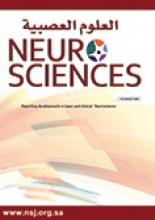To the Editor
We have read with interest the original article entitled “Awareness of patients with multiple sclerosis in Saudi Arabia regarding the relationship between smoking and multiple sclerosis” by Lujain F. Bashamakh et al at elpublished in the Neurosciences.1 I want to commend the authors for this successful cross-sectional survey and a significant contribution towards the association between smoking and awareness among Multiple Sclerosis (MS) patients.
There are certain methodological concerns which might create response bias among patients suffering from MS. First, the diurnal variation of mood,2 level of attention,3 and the amount of sleep gets affected in MS. Second, researchers must be aware of the level and intensity of disabilities associated with MS, such as depression, anxiety4 and fatigue.5 These factors create unintentional response bias in a self-administered questionnaire or during the interview. To the best of our knowledge, none of the above-stated factors were controlled or mentioned in the limitations of study.
The following are the recommendations for future researches.
1. The diurnal variation of mood and fatigue can be made homogenous by choosing a specific time of the day.
2. The split questionnaire design method can be used in patients showing high levels of fatigue.6
Reply from the Author
We appreciate your interest and comment on our recent study.1 Your letter raised important factors that could lead to bias in any study related to multiple sclerosis (MS) patients. Mood disorder and fatigue are common among MS patients.7 However, we tried to limit the effect of these factors by giving the patients the options of either self-administered questionnaire, where the patients fill in the questionnaire by themselves; or phone based interview. Questionnaire time was relatively short (less than 20 minutes) to minimize the effect of cognitive fatigue. The MS fatigue could have circadian rhythm, where patient may feel more fatigue at the end of the day.8 However, fatigue could vary from day to day in the same MS patients with stress, physical exercise and other less known factors.9 Therefore, doing the questioner at a specific time of the day couldn’t ensure homogenous results. Finally, the idea of split questionnaire is a compelling method for data collection especially in long questionnaires. We believe it is difficult to perform split questionnaire in relatively small sample size (162 patients).6 We would like to thank you for the valuable comments which will be taken in consideration in future researches.
Lujain F. Bashamakh, Shouq M. Alsharif, Lamis A. Wayyani, Alaa E. Alghamdi, Ghaida M. Fatani, Faculty of Medicine, King Abdulaziz University, Jeddah, Hind A. Alnajashi,
Faculty of Medicine, Department of Medicine, Neurology Division, King Abdulaziz University, Foziah J. Alshamrani, Department of Neurology, King Fahad Hospital of the University, Imam Abdulrahman Bin Faisal University, Dammam, Saudi Arabia.
- Copyright: © Neurosciences
Neurosciences is an Open Access journal and articles published are distributed under the terms of the Creative Commons Attribution-NonCommercial License (CC BY-NC). Readers may copy, distribute, and display the work for non-commercial purposes with the proper citation of the original work.






